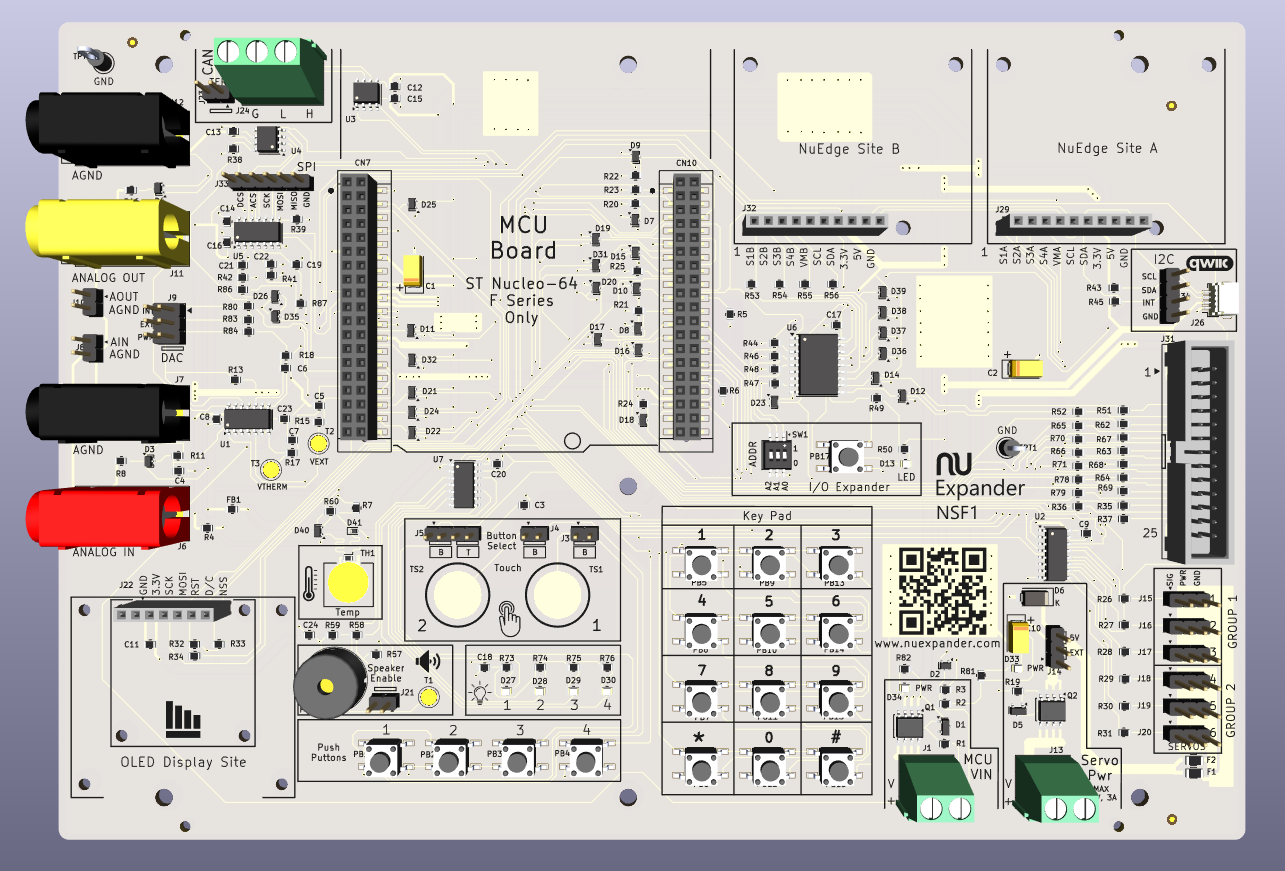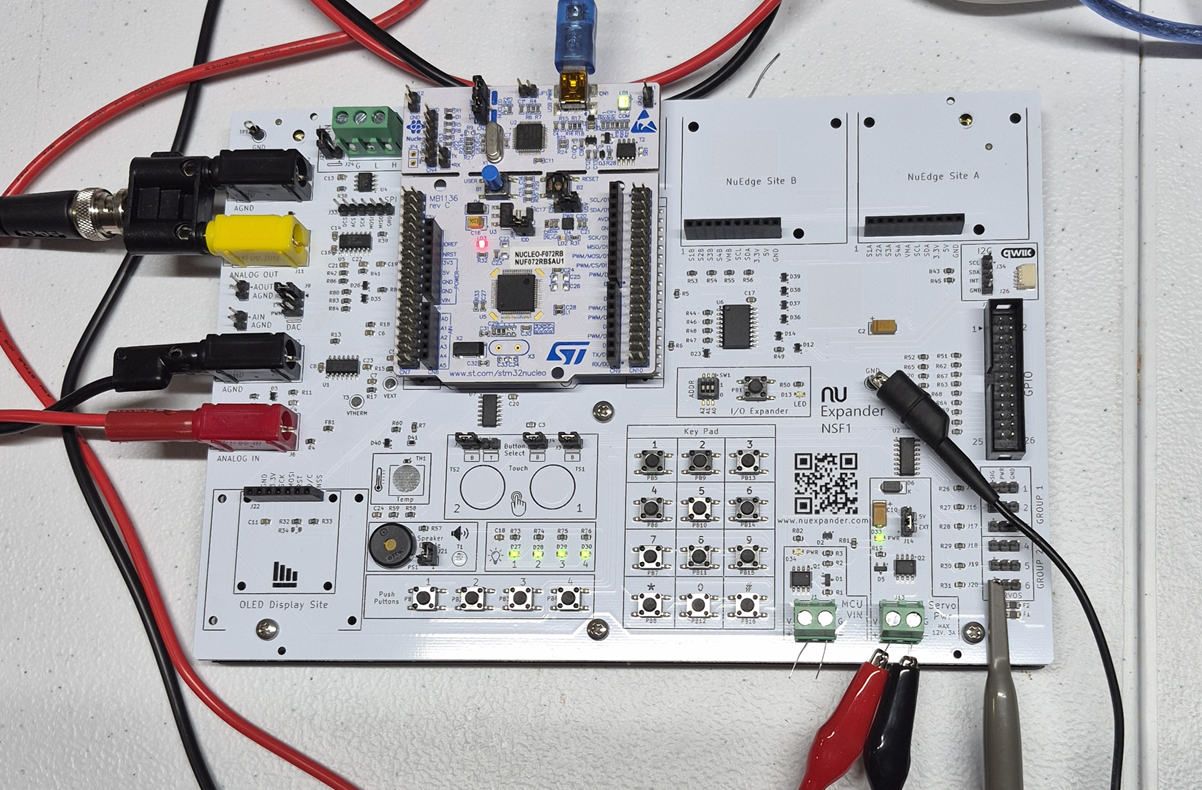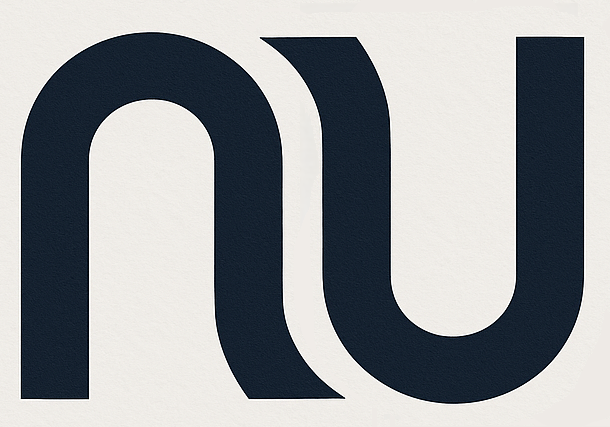Integrated I/O platform for STM32 Nucleo-64.
Focus on concepts, not connectors.
NuExpander-NSF1 turns an STM32 Nucleo-64 development board into a classroom-ready, all-in-one microcontroller I/O lab — replacing a stack of shields and breakouts. Designed for lab or distance learning: consistency, fewer failure points, and less support overhead.

Features at a glance
- Analog output: Buffered internal DAC, external DAC (SPI) or PWM. Banana sockets with standard spacing.
- Analog input: Buffered analog signal to an ADC channel. Banana sockets with standard spacing.
- External SPI ADC: Read various voltages on the board. NuEdge analog signals, servo power
- I²C/SPI breakouts: Pin headers for observation
- STM32 Nucleo-64 development board: See the FAQ for supported boards.
- CAN I/O: CAN transceiver with terminal block connection and jumpered 120 Ω line termination.
- NuEdge expansion sites: UART transceivers, motor drivers, etc.
- Qwiic connector: I²C expansion using Qwiic
- I²C I/O expander: Additional 8 GPIO with a dedicated pushbutton and LED.
- GPIO header: Assortment of 3.3V and 5V digital I/O with 3.3V and 5V power.
- Servo motor connectors: Six standard 3 pin servo motor connectors (PWM, power and GND) - PWM is true 5V logic.
- External servo power: Screw terminal supporting up to 3 amps of servo motor power with reverse polarity protection.
- Touch pads: Two pads connected to the Touch Sensitive Controller.
- Keypad: 3x4 scanning keypad
- LEDs: Four general purpose LEDs
- Pushbuttons: Four general purpose pushbuttons
- Speaker: Piezo speaker connected to a buffered timer output
- Thermal touch pad: Offset and scaled thermistor connected to an ADC channel. Touch to change the temperature.
- OLED graphics display site: OLED display with SPI interface, 0.96" or 1.56" size.
- VIN connector: VIN to the microcontroller board with reverse polarity protection.
Who benefits
For faculty
Reduce lab setup time and errors, align to outcomes and clearly show cause-and-effect.
For students
Touch hardware, read registers, build intuition—from blink to touch.
For programs
Low-cost platform with reusable labs and documentation; scales from intro to advanced.
Features - All‑in‑one I/O lab (less clutter, more clarity)
Analog output
→ Buffered internal DAC, external DAC (SPI) or PWM. Banana sockets with standard spacing
Analog input
→ Buffered analog signal to an ADC channel. Banana sockets with standard spacing
External SPI ADC
→ Read various voltages on the board. NuEdge analog signals, servo power
I²C/SPI breakouts
→ Pin headers for observation
STM32 Nucleo-64 development board
→ See the FAQ for supported boards
CAN I/O
→ CAN transceiver with terminal block connection and jumpered 120 Ω line termination
NuEdge expansion sites
→ UART transceivers, motor drivers, etc.
Qwiic connector
→ I²C expansion using Qwiic
I²C I/O expander
→ Additional 8 GPIO with a dedicated pushbutton and LED
GPIO header
→ Assortment of 3.3V and 5V digital I/O with 3.3V and 5V power
Servo motor connectors
→ Six standard 3 pin servo motor connectors (PWM, power and GND) - PWM is true 5V logic
External servo power
→ Screw terminal supporting up to 3 amps of servo motor power with reverse polarity protection
Touch pads
→ Two pads connected to the Touch Sensitive Controller
Keypad
→ 3x4 scanning keypad
LEDs
→ Four general purpose LEDs
Pushbuttons
→ Four general purpose pushbuttons
Speaker
→ Piezo speaker connected to a buffered timer output
Thermal touch pad
→ Offset and scaled thermistor connected to an ADC channel. Touch to change the temperature.
OLED graphics display site
→ OLED display with SPI interface, 0.96" or 1.56" size
VIN connector
→ VIN to the microcontroller board with reverse polarity protection
Milestones

Early bring-up is underway. More details soon.
Join the early‑access list
Get milestone and documentation updates. Register interest in early adoption. No spam and we will not share your info.
Quick FAQ
Which STM32 Nucleo-64 boards are supported?
Do I have to use STM32Cube HAL?
What is the Qwiic interface?
What labs are included? Can I write my own labs?
What lab equipment is required?
How robust is the NuExpander?
Can the NuExpander be expanded?
What are NuEdge boards?
Are the NuExpander and NuEdge boards open hardware?
How does NuExpander support distance learning?
Pricing?
Affiliation & Trademarks
NuExpander is an independent project and is not affiliated with, sponsored by, or endorsed by STMicroelectronics N.V.
- STMicroelectronics: “STM32”, “Nucleo”, and other ST product names are trademarks or registered trademarks of STMicroelectronics.
- SparkFun: “Qwiic” is a trademark of SparkFun Electronics.
- All other trademarks are the property of their respective owners.
